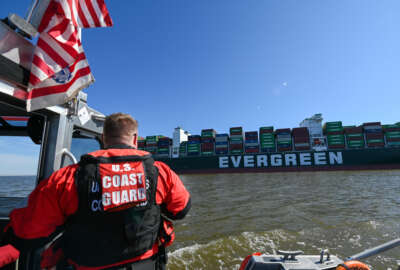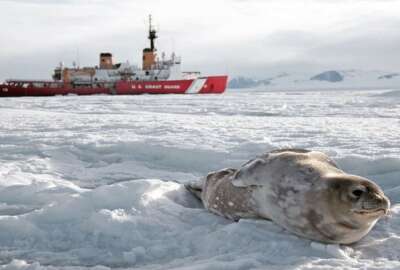Coast Guard’s Project Titanic patrols the arctic for hazardous icebergs
Ever since the aftermath of the Titanic disaster, the Coast Guard has been patrolling the North Atlantic for icebergs that could pose hazards.
Best listening experience is on Chrome, Firefox or Safari. Subscribe to Federal Drive’s daily audio interviews on Apple Podcasts or PodcastOne.
Ever since the aftermath of the Titanic disaster, the Coast Guard has been patrolling the North Atlantic for icebergs that could pose hazards. They started with ships, then moved to fixed-wing aircraft. Now, as part of a partnership with the Department of Homeland Security’s Science and Technology directorate, satellites, Matthew Barger is program manager for maritime safety in the DHS Science and Technology directorate, and Marcus Hirschberg is commander of the Coast Guard’s International Ice Patrol. They talked with Federal News Network’s Jared Serbu about what DHS is calling “Project Titanic,” on the Federal Drive with Tom Temin.
Interview transcript:
Jared Serbu: Commander Hirschberg, I think you’d like to start with you. I think it’s fair to say this is not the most famous of Coast Guard missions. So if you could take us through a little bit, the elevator pitch of what the mission of the Ice Patrol actually is, as it’s done today, and maybe some of the hazards that you’re trying to mitigate right now.
Marcus Hirschberg: Sure, I’m happy to. So while our mission is not the most famous is one of our oldest missions. So Ice Patrol came about in 1914. So as everyone will recall, in 1912, the Titanic tragedy occurred, and she sank off the coast of Newfoundland and more than 1,500 people were lost in this mass casualty event at sea. Following the extreme outrage in North America and in Europe, the public demanded action. And the first international convention for the safety of life at sea was brought together and that convention established the International Ice Patrol and stated that the U.S. Coast Guard would be in charge of managing the International Ice Patrol. So starting in 1914, that’s what we did. In the early days, we used cutters or ships to follow the iceberg populations as they transited south following the Labrador current or what we call “iceberg alley.” In later years following World War II, we began to use aircraft for visual patrols. And now we use aircraft using visual and radar but are currently transitioning to the use of satellites only to conduct our mission.
Jared Serbu: All right, that’s a really good setup. So let’s talk about some of the space-based technology that may come into play here. Matthew, how did you get tied in with this mission requirement and figure out that these commercial satellite capabilities might actually be helpful here?
Matthew Barger: Yeah, thanks. So I think the important piece is S&T as a service organization, we service the component needs. So when Coast Guard, ICE, [Customs and Border Protection] bring us work to do, we look at the available technologies, look at the available solution spaces. And in this case, the Ice Patrol was a customer we could service with the existing and future commercial space capability. So iceberg surveillance was really costly. Coast Guard wanted to have us help them with addressing that. The aviation hours were extensive. And so cost savings and availability of technology to help them with that mission was very important. The access that satellites provide, the ability for satellites to data collect faster, and then the sensor technologies that have improved over the decades, since Ice Patrol was founded, is significant. So synthetic aperture radar, radar’s technology on a space asset is what’s used with this project. And really, it’s a much wider area. The ocean is big and so science and technology took up the challenge to be able to detect these icebergs on a larger scale than ever before.
Jared Serbu: So the coverage area, obviously a lot greater than what you would get out of an aviation fleet. But for either one of you, talk about the kind of fidelity of the imagery that you get compared to what you would get from a sensor package on the C-130.
Marcus Hirschberg: So right now we’re using what would be considered fairly low-resolution Synthetic Aperture Radar (SAR) satellites. We make a lot of use right now of the European Space Agency’s Sentinel-1, SAR satellites. They’re at a 20-meter resolution. So we currently, we really can’t use them to detect an iceberg smaller than 20 meters. So that’s why in the coming years, we’re using aircraft to validate our satellite analysis, and also transitioning to the use of higher resolution imagery. But to put that in comparison, so the aircraft we use have a very sophisticated airborne radar that’s been around for some years now, and is able to use some other technologies to basically provide a radar image, which is better than what we’re seeing from the satellites right now. But satellite resolution is advancing rapidly.
Jared Serbu: And Matthew, it sounds like – sorry, I didn’t mean to cut you off here – but it sounds like the long-term vision here is to continuously use commercial satellite capabilities here. We’re not talking about DHS launching its own payloads.
Matthew Barger: That’s correct. Yeah, the space industry is really undergoing a revolution. I think that’s the point here is the government is really benefiting from the commercial sector taken off. The spacecraft themselves are getting smaller, cheaper, more prolific on orbit. I think commercial imagery, you’ll see the constellations will be much more robust, where satellites that have the ability to rapidly image the sea land and multidomain. So DHS benefits greatly from those enhanced situational awareness capabilities that we’re seeing in the commercial market. And Coast Guard, certainly with one of the biggest mission spaces of our department is one of the prime beneficiaries of the program that I run.
Jared Serbu: And Commander, medium-to-long term, is it likely or possible that this satellite-based effort puts your C-130 pilots out of business? Or is there always going to be a need for aviation capabilities here?
Marcus Hirschberg: So what the medium term is we’ll no longer be using C-130 aircraft for our mission. Currently, we use 500 hours of C-130 time to conduct our mission. And that costs about on average, about $10 million a year. Now, the Coast Guard, what they’re gonna get back is those 500 hours, they’ll be able to use that for other missions, counterdrug, hurricane response, that sort of thing. But absolutely, in the coming years, we’re going to let go of those aircraft. It’s bittersweet for us. That’s a real been a really powerful part of our history, we’ve worked with our partners at Air Station Elizabeth City, North Carolina, for many decades now. So it’s really winding down a key part of our mission, but it absolutely makes sense to use resources better than we currently are.
Jared Serbu: So I guess the point there is there’s enough confidence in this satellite imagery that you don’t think there’s a high probability that you’re going to miss stuff.
Marcus Hirschberg: Yes, we have high enough competence, and that is only increasing. So this past summer, International Ice Patrol relocated. We were located in Connecticut for many years, and we relocated to the National Capital Region. We’re in Suitland, Maryland, right now, at the NOAA satellite operations facility. One of the main reasons for that move was to build on some of our partnerships, so we can work with interagency partners who have commercial satellite contracts, and use some of their best practices for our operations. So it really makes sense for us to be here in D.C.
Jared Serbu: And Matthew, looking across the rest of DHS, I mean, where are some obvious places where this same technology or similar technologies might make sense? I mean, things that come to my mind, even just in the Coast Guard mission space would be things like looking for drug launches or migrant vessels or other things that might suit their intel needs. But across the rest of the components, where else could you use this?
Matthew Barger: Yeah, so I think that the capabilities of space are very, it’s the wide area of the Earth, it’s the big changes in the environment. So there’s some natural ties to natural disaster, sensing any kind of change in change motion, in the surface of the earth. Satellites are really a great technology for that. Communications is another one. So these satellite-based assets, also provide a ton of communication capability to DHS, not this specific radar satellite, but others. So space-based is a tremendous capability. We’ve been looking heavily in investing into that area, to bring a lot of those air and land and maritime technologies to enhance those. Floods is a great example, anytime there’s a flood, a change detection capability of a satellite is a big benefit. I will add that also a benefit of this technology is that it’s immune to darkness. So a lot of the aviation assets, some of the physical eyeballs of the pilots or the aircraft crews, darkness has always been one of those challenges. The satellite images, radar doesn’t need a light source, and also the difficult-to-reach location. So the commander brought up the icebreaker fleet. There’s lots of areas that satellite can now provide images in those remote and hard to reach areas. So I think the upstream environment that these icebergs come from is another potential area that could be benefited from this technology.
Jared Serbu: I’m glad you brought that up because I was gonna ask to do these only operate in the visible spectrum. So is cloud cover still going to be a problem? Or can they see through clouds, too?
Matthew Barger: There’s a certain amount of cloud cover. It’s sending out energy and receiving the energy back and imaging it from it. So there is a certain amount of cloud cover it won’t be able to penetrate. But there is an inherent benefit to not relying on a light source, the reflection of light to be able to collect against.
Marcus Hirschberg: Yeah, I’ll say from the Coast Guard’s point of view, this is a good thing for our workforce. So we do have some geospatial intelligence analysts within the U.S. Coast Guard. But that was really a niche, within Coast Guard intel that was a very small community. So this kind of doubles the number of geospatial analysts we have within Coast Guard intel, allows us to get a return on investments. There’s a lot of training that goes into that and they can follow that on with another two or three assignments during their career instead of just using it once and then moving to something totally different.
Jared Serbu: For example, they could be doing the ice mission during ice season and other things when it’s not ice season, I imagine right?
Marcus Hirschberg: Potentially yes and I’ll just add from from Ice Patrol’s perspective. So we’re also co-located with the U.S. National Ice Center, which is a joint Navy-NOAA [National Oceanic and Atmospheric Administration] command that basically provides ice warning for the rest of the globe for U.S. ships. So we’re now next to them. So they have a lot of missions that we can probably combine forces on, the Coast Guard’s gonna have new generations of icebreakers coming out and they’re gonna need onboard ice analysts. So, outside of iceberg season, there’s a lot more we can take on.
Jared Serbu: Got it. Okay, let’s talk a bit about timeline here. How far off is actual full operational capability here when you might start to draw down some of those aviation assets?
Marcus Hirschberg: Our plan is to not request any aircraft hours in 2025, so two more seasons of flying after this year. That will give us time to validate what we’re doing back at our operations center, and make sure we’re not missing anything.
Jared Serbu: But real capabilities online sooner than that, obviously, before you stop requesting aviation assets.
Marcus Hirschberg: Yes, there will be a significant testing.
Copyright © 2025 Federal News Network. All rights reserved. This website is not intended for users located within the European Economic Area.
Tom Temin is host of the Federal Drive and has been providing insight on federal technology and management issues for more than 30 years.
Follow @tteminWFED







